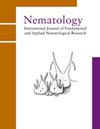环状榕蛾(线虫纲:环状榕蛾科),中国环状榕蛾的副属
IF 1.2
4区 生物学
Q2 ZOOLOGY
引用次数: 1
摘要
从西双版纳环形榕属的悬铃木中发现一新种。本文将其描述为环状Ficophagus annulatae n.sp.,其特征在于具有短PUS(9-18μm或0.3-0.6 VBD长)、位于管心针基底结节和中心体之间的排泄孔(EP)、硬壳虫、变形虫精子、雄尾上的三对盘下乳头(一对仅为泄殖腔(P2),一对在泄殖腔孔和尾端之间(P3),一对在尾尖附近(P4)),雄性尾尖圆形,无短尖头,无引带和弓状刺,喙部模糊。通过部分小亚基(SSU)rRNA基因和大亚基(LSU)rNA基因的D2-D3扩增片段,Ficophagus annulatae n.sp.与其他测序物种分化。利用LSU D2-D3扩增片段序列进行的系统发育分析表明,环孢F.annulatae n.sp.与benjamina、curtipes和microcarpus聚在同一个高度支持的单系分支中。它在形态上与这些物种的EP位置、针状物和子宫形态以及一些形态计量学特征不同。本文章由计算机程序翻译,如有差异,请以英文原文为准。
Ficophagus annulatae n. sp. (Nematoda: Aphelenchoididae), an associate of Ficus annulata in China
A new species of the genus Ficophagus was recovered from the syconia of Ficus annulata from Xishuangbanna, Yunnan province, China. It is described herein as Ficophagus annulatae n. sp. and is characterised by possessing the combined characters of a short PUS (9-18 μm or 0.3-0.6 VBD long), an excretory pore (EP) located at the level between stylet basal knobs and metacorpus, presence of crustaformeria, amoeboid sperm, three pairs of subventral papillae on the male tail (one pair just adcloacal (P2), one pair halfway between cloacal aperture and tail terminus (P3), and one pair near tail tip (P4)), rounded male tail tip without mucron, absence of gubernaculum and bow-shaped spicule with indistinct rostrum. Ficophagus annulatae n. sp. was differentiated from other sequenced species by the partial small subunit (SSU) rRNA gene and D2-D3 expansion segments of the large subunit (LSU) rRNA gene. Phylogenetic analysis with the LSU D2-D3 expansion segment sequence suggested that F. annulatae n. sp. is clustered in the same highly supported monophyletic clade with F. benjamina, F. curtipes and F. microcarpus. It differs morphologically from these species in EP position, spicule and uterus morphology, and some morphometric characters.
求助全文
通过发布文献求助,成功后即可免费获取论文全文。
去求助
来源期刊

Nematology
生物-动物学
CiteScore
2.60
自引率
33.30%
发文量
67
审稿时长
3 months
期刊介绍:
Nematology is an international journal for the publication of all aspects of nematological research (with the exception of vertebrate parasitology), from molecular biology to field studies. Papers on nematode parasites of arthropods, and on soil free-living nematodes, and on interactions of these and other organisms, are particularly welcome. Research on fresh water and marine nematodes is also considered when the observations are of more general interest.
Nematology publishes full research papers, short communications, Forum articles (which permit an author to express a view on current or fundamental subjects), perspectives on nematology, and reviews of books and other media.
 求助内容:
求助内容: 应助结果提醒方式:
应助结果提醒方式:


